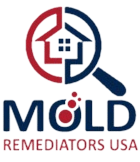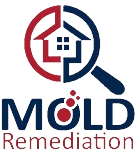Professional Mold Removal Services USA
Mold Remediators USA provides professional mold removal services to safely remediate and remove mold from your home or business. Their expert technicians use cutting-edge equipment and techniques to ensure a thorough and effective mold removal process.
Residential & Commercial Mold Removal
Mold Remediation company USA offers residential and commercial mold removal services designed to address mold issues effectively. Their residential services include thorough inspections, advanced containment, and comprehensive removal and restoration to ensure a safe living environment. For commercial properties, they provide detailed assessments, sophisticated containment strategies, and efficient mold remediation usa to minimize operational disruption. Both services emphasize moisture control, thorough cleaning, and preventive measures to prevent future mold growth, delivered with professional expertise and a commitment to high-quality results.
Certified Mold Removal Specialists
Certified mold removal specialists are professionals who have completed accredited training and certification programs in mold remediation and removal. These specialists are equipped with the knowledge and skills to effectively identify, contain, and eliminate mold problems in residential and commercial settings. Certification ensures they adhere to industry standards and best practices, use appropriate safety measures and equipment, and provide thorough mold assessment, removal, and prevention services.
Mold Removal Process:
The mold removal process typically involves several key steps:
- Assessment: Find out how bad the mold and how much moisture is fueling growth. This can be a visual assessment, moisture testing, and sometimes a mold identification test via air or surface sampling.
- Isolation: Isolation efforts attempt to keep mold spores from spreading throughout the property. Generally, this might include sealing off the contaminated area with plastic sheeting and using negative air pressure machines to “tent” the area, maintaining a negative pressure.
- Remove Possibly Infectious/Infested Material: moldy building materials such as drywall, carpeting, insulation and other building components that have become saturated with water and thus mold growth needs to be removed to curb the source of mold growth. Non-absorbent materials can be cleaned and disinfected to remove the mold.
- Cleaning and Disinfection: Contaminated porous (items that hold moisture) and semi-porous materials (items with web-like pores that can become encrusted and trap moisture, such as sheetrock and grouted tile) like floor coverings, carpet padding, insulation, wallboard, fabric, clothing, upholstery, and stuffed toys in the contaminated area are cleaned and disinfected to prevent resurgence of mold spores. Use of specialized HEPA-vacuums and mold-specific cleaning solutions can be used to facilitate the cleaning process.
- Drying and Dehumidification: Once the contaminated areas have been cleaned up, drying and dehumidification can commence to help prevent additional moisture from collecting and forming mold. Fans, dehumidifiers, and other drying equipment can be employed to reduce moisture levels.
- Post-Remediation Verification: Following the removal of mold, it may be possible to perform post-remediation verification. For example, you may want to conduct a visual inspection, air sampling or surface testing to make sure that mold levels are acceptable.
- Preventive Precautions: Finally, steps may be taken to minimize the risk of future mold growth. For instance, leaks may be repaired, ventilation increased, and indoor humidity conditions improved.
Remove Mold from Home
To remove mold from home involves a comprehensive process of eliminating mold contamination and preventing its return. This includes conducting a detailed inspection and testing to assess the extent of mold growth and moisture sources, implementing containment measures to prevent the spread of spores, using specialized equipment and cleaning agents for removal, and thoroughly drying affected areas with industrial-grade dehumidifiers and fans. The process also involves repairing and restoring damaged materials, addressing moisture issues to prevent future growth, and conducting follow-up inspections to ensure complete remediation and indoor air quality.
Residential & Commercial Mold Cleaning Services
Residential and commercial mold cleaning services involve a range of specialized processes to address and remove mold contamination from both homes and businesses.
Finally, the mold removal process enables humans to live and work in an environment free of harmful mold and, the most important thing, enables us to breathe correctly and stay healthy. The process transforms the environment back to a home and/or workplace. It is now safe for the humans who live in it. The mold removal should be conducted by mold removal specialists in USA who have the education, training, certification, experience, and support team to conduct the work safely, effectively, and properly, ensuring a safe environment.
Why Choose Professional Mold Removal Service in USA
Expertise and Experience
With years of experience in the industry, our certified professionals are equipped with the knowledge and skills to tackle any mold issue, big or small. We stay updated with the latest industry standards and best practices to provide you with the best service possible.
Comprehensive Services
Our mold removal services cover every aspect of mold remediation, including inspection, testing, removal, and prevention. We use advanced equipment and techniques to detect hidden mold, ensuring no spot is left untreated.
Transparent Pricing
We offer fair and transparent pricing with no hidden costs. Our detailed estimates provide a clear breakdown of the work needed and the associated costs, so you know exactly what you’re paying for.
Eco-Friendly Solutions
We use environmentally friendly products and methods to remove mold without harming the environment. Our green solutions are safe for you and the planet, ensuring a healthy living and working environment.
Mold Removal FAQs
The best way to remove mold from home is to clean affected areas with a mixture of water and detergent or a specialized mold remover. For small areas, you can scrub the mold off with a brush. For larger infestations, consider hiring a professional mold remediation service.
A mold removal service physically gets rid of the mold you can see on walls, fabrics and furniture in your home. Essentially, it deals with the symptoms of mold. It can be used to improve the air quality of your home and stop health problems from getting any worse, but it doesn’t actually solve the problem. Mold remediation, on the other hand, deals not only with removing the mold but fixing it so it doesn’t come back, and getting rid of underlying moisture. It really treats the whole problem by addressing both the symptoms and the cause of mold. The other key difference between mold removal and mold remediation is that mold removal usually merely targets the mold, while remediation targets the actual source of the problem.
You should consider professional mold removal services if you encounter:
– Visible Mold Growth: Dark spots or patches on walls, ceilings, or floors.
– Persistent Musty Odors: Indicating hidden mold or widespread infestation.
– Health Symptoms: Allergies, asthma, or respiratory problems worsened by indoor conditions.
– Water Damage: Recent leaks or flooding causing dampness and mold growth.
– Large Infestations: Mold covering areas larger than 10 square feet or spreading rapidly.
– Repeated Mold Issues: Mold returning after DIY mold cleaning or remediation attempts.
Professionals can effectively address significant mold problems and ensure thorough removal.
Professional mold removal typically involves these steps:
– Mold Inspection and Assessment: Evaluating the extent of mold growth and identifying affected areas.
People wanted to make their home a safer, healthier place to be, and to prevent mold from spreading elsewhere in the building containment, making the area safe by sealing off the affected areas to keep spores from spreading to other parts of the building.
– Air Filtration: Using HEPA filters to clean the air and capture airborne mold spores.
– Mold Removal: Physically removing mold from surfaces using specialized cleaning agents and techniques.
– Cleaning and Disinfection: Thoroughly cleaning and sanitizing surfaces to eliminate residual mold spores.
– Safe Disposal: Properly disposing of mold-infested materials to prevent contamination.
These steps will help clear the mold and keep your indoor air cleaner.
Whether you have to evacuate your home during a mold remediation project or not depends on the size and severity of the mold problem. For smaller, localized mold removal projects, staying out of portions of the home might be sufficient. However, if the project is larger or there is an extensive mold problem or the contaminated materials need to be cleaned aggressively, it may be safer and smarter to evacuate the home for the duration of the project. But your professional will let you know for sure.
To prevent mold from returning after you remove mold from home, control humidity levels (ideally below 50%), ensure proper ventilation, fix any leaks, and keep moisture-prone areas dry.
Professional mold removal addresses various types of mold, including:
– Stachybotrys chartarum (Black Mold): Known for its potential toxicity and health risks.
– Aspergillus: Common indoor mold that can cause allergies and respiratory issues.
– Penicillium: Often found in water-damaged buildings, can cause allergic reactions.
– Cladosporium: Typically found on wood, textiles, and other damp surfaces.
– Alternaria: Common in damp areas like showers and sinks, can trigger asthma and allergies.
All types of mold can be handled by professionals and can be completely eliminated to prevent further health hazards.
To prepare for a mold removal service in your home:
– Clear the Area: Remove personal items, furniture, and valuables from the affected area.
– Seal Off Unaffected Areas: Close doors and windows to prevent mold spores from spreading.
– Protect HVAC Systems: Turn off HVAC systems or seal vents to avoid contamination.
– Make a Temporary Arrangement for Accommodation: If the mold removal required strong chemicals, arrange for a temporary accommodation
– Talk to Professionals: Discuss a customised gameplan with your mold removal team in regards to any special preparation requirements.
Preparing your home helps ensure an efficient and safe mold removal process.
Successful mold removal is indicated by:
– Absence of Visible Mold: No remaining mold patches or stains on previously affected surfaces.
– No Musty Odors: Elimination of persistent musty smells associated with mold.
– Improved Air Quality: Cleaner indoor air with no mold-related health symptoms.
– Dry Conditions: Effective moisture control and no new signs of dampness or water damage.
– Positive Post-Removal Testing: If air or surface samples show normal mold levels after removal.
– Professional Verification: Evidence that the mold remediation goals have been met, by the contractor hired for remediation. After the work is complete, either bioaerosol measurement can be repeated or clearance tests for molds, endotoxin and other potential health concerns can be completed.
These signs verify that mold has been eliminated and the environment is safe and clean.
Common signs that you need to remove mold from home include visible growth on surfaces, a musty odor, and health symptoms like sneezing or coughing. If you suspect mold but can’t see it, consider using a home mold test kit.

